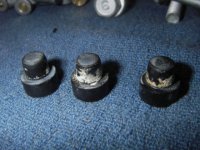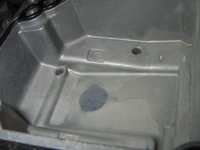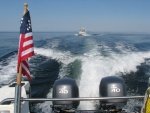thataway
Well-known member
- Joined
- Nov 2, 2003
- Messages
- 21,695
- Reaction score
- 69
- C Dory Year
- 2007
- C Dory Model
- 25 Cruiser
- Hull Identification Number
- DOR25652A707
- Vessel Name
- thataway
Let me add to the type of things we do to our boats somewhat as a supplement to Jay's excellent list: Lifting davit to put the dinghy on the roof and move heavy items in the cockpit. (about $400). Decadence Carpet (About $ you don't want to know, but the Admiral is happy with it) but over a boat unit. Dry deck lining in all lockers between the hull; ($200) Battery monitoring system: Victron 702 $200, LED lighting upgrades (including in cabinets). $200. fans: $300. (plus portable for forward hatch or forward window)
No See-um screens for all windows and door. ($15 Army surplus net and velcro). Camper back (If Bimini and any parts not present--can be up to $5000). AIS receiver. and second radio ($300 plus)
Upgrade battery charger--the ones which come with the boat are designed for slow charge after you have been out for a day. If you are doing serious cruising: using refrigerators, freezers, fans or heater. etc--you may need a 20 amp charger to utilize the best management of the batteries. The factory charger will fail at some point. We do go to AGMs if the batteries check out weak or are over 4 years old, with unknown maintenance.
CO monitor--we have two--one by the helm and one by the head of the bunk. $75. Graphics for the name and hailing port: (from $5 to $400). Anchor windlass, new anchor roller, better anchor, rode and chain. (8 plait with G4 chain; second stern anchor: total cost can be in the $500 + range. Also stern line to the bank. Add new windows to trunk cabin over berths: $250. How about crab and shrimp traps? Fishing gear?
We have kept the same dinghy and motors (Inflatable with air floor $1500, Torqeedo 1003 (two boat units), and 3.5 two stroke Marc $1200.
You don't like the XX stove--and a new one may be from $30 (propane from WalMart) to over $3000 (Diesel Wallas from Scan Marine).
Bottom paint: epoxy undercoat--can be over 2 boat units.
Winter full cover--$500 to $1000+.
None of the above are essential; you can be like Jonathon Arthur and do the loop with an I phone, a $90 depth finder and a couple of 5 gallon plastic containers to ferry gas to the boat in. I believe he added a chart plotter for the 3rd time around.
No See-um screens for all windows and door. ($15 Army surplus net and velcro). Camper back (If Bimini and any parts not present--can be up to $5000). AIS receiver. and second radio ($300 plus)
Upgrade battery charger--the ones which come with the boat are designed for slow charge after you have been out for a day. If you are doing serious cruising: using refrigerators, freezers, fans or heater. etc--you may need a 20 amp charger to utilize the best management of the batteries. The factory charger will fail at some point. We do go to AGMs if the batteries check out weak or are over 4 years old, with unknown maintenance.
CO monitor--we have two--one by the helm and one by the head of the bunk. $75. Graphics for the name and hailing port: (from $5 to $400). Anchor windlass, new anchor roller, better anchor, rode and chain. (8 plait with G4 chain; second stern anchor: total cost can be in the $500 + range. Also stern line to the bank. Add new windows to trunk cabin over berths: $250. How about crab and shrimp traps? Fishing gear?
We have kept the same dinghy and motors (Inflatable with air floor $1500, Torqeedo 1003 (two boat units), and 3.5 two stroke Marc $1200.
You don't like the XX stove--and a new one may be from $30 (propane from WalMart) to over $3000 (Diesel Wallas from Scan Marine).
Bottom paint: epoxy undercoat--can be over 2 boat units.
Winter full cover--$500 to $1000+.
None of the above are essential; you can be like Jonathon Arthur and do the loop with an I phone, a $90 depth finder and a couple of 5 gallon plastic containers to ferry gas to the boat in. I believe he added a chart plotter for the 3rd time around.





